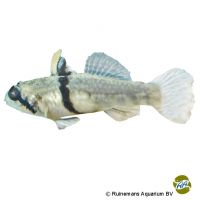Rhinohorn Goby (Redigobius balteatus)
| Rhinohorn Goby Redigobius balteatus | |
|---|---|
| Name | Rhinohorn Goby |
| Name Lat. | Redigobius balteatus |
| Family | Gobies |
| Family lat. | Gobiidae |
| Order | Gobies |
| Order lat. | Gobiiformes |
| Origin | Southeast Asia |
| Habitat | Estuaries, streams |
| Diet | Carnivore |
| pH | 7.5-8.5 |
| Behavior | Peaceful |
| Keeping | Pair, group |
| Care Level | Difficult |
| Reproduction | Cave spawner |
| Breeding | Difficult |
| Life Span | N/A |
| Protection | No |
| Metric Units | |
| Size | 4 cm |
| Temperature | 24-28 °C |
| Hardness | 10-20 °dH |
| Aquarium | ~ 60 l |
| US Units | |
| Size | 1.6" |
| Temperature | 75-82 °F |
| Hardness | 178-356 ppm |
| Aquarium | ~ 15 gal |
Distribution and habitat
Vaimosa gobies are widely distributed in the coastal areas of the Indo-Pacific, from the east coast of Africa to Madagascar, Sri Lanka, Indonesia, Vietnam, New Guinea, Australia and the Philippines. They live mostly in the brackish water of estuaries and in streams with direct access to the sea
Maintenance
The aquarium should be structured with round river pebbles, flat stones, caves and shelters as well as some hardy plants (e.g. java fern). A fine-grained substrate and medium-hard to hard, slightly alkaline water with a moderate current is ideal.
No ammonia, ammonium and nitrite should be detectable, the nitrate value should not exceed 100 mg/l. To ensure the water quality and oxygen content, a filter and heater adapted to the aquarium size is required, as well as lighting for the species-appropriate day-night rhythm of the animals.
Diet
In the wild they feed on insect larvae, small crustaceans and zooplankton. The food supply consists of live and frozen food. Feed once daily with cyclops, daphnia, bosmids, artemia or mosquito larvae (live or frozen). Protein-rich, sinking dry food is very rarely accepted and should not be a main component of the diet.
They are slow eaters. It is recommended to feed small portions several times a day. Only feed as much as will be eaten within a few minutes. A regular and varied diet promotes health and increases resistance
Behaviour and compatibility
Juveniles are very peaceful and live in groups. Adult males form small territories which they defend. They should be kept in pairs or in a small group where aggression is better distributed. Keeping a group, two males with several females, is recommended only in a larger and richly structured tank. They can be well socialized with fish that stay in the upper water region, but it is better to keep them in a species tank. Basically, only compatible fish species with similar demands on water condition and water temperature should be socialized.
Sex dimorphism
Males have a more bulbous head, a more deeply cleft mouth, and a pennant-like extended first dorsal fin and a more developed second dorsal fin.
Reproduction and breeding
There are only a few reports of successful breeding in the aquarium. The numerous, very small eggs are usually laid on the walls of a cave or crevice and guarded by the male. The larvae hatch after 3-4 days and float in the water (pelagic development). They begin to ingest minute food (rotifers) immediately after their yolk sac is depleted. The rearing of the larvae, which are about 2 mm in size, is very difficult.
Important
Gobies like to sit on flat or round rocks.
Soft water, below 8° dGH, is not tolerated in the long run. For permanent keeping, the addition (1 tablespoon per 10 l water) of sea salt (mineral salt) from the pet store is recommended for water hardening.
The well-being of the fish should be checked regularly. The temperature should be checked daily, the pH value, hardness and nitrate value at least every 14 days. Regular partial water changes are recommended, even if the contaminant level has not yet reached the upper limit. Sudden changes in water quality should be avoided. Newly introduced fish must be accustomed slowly to the water in the aquarium.
Further literature can be found in your pet store.
References
Text: petdata; Image: Ruinemans Aquarium B.V.
Source: BMEL (1998): Tierschutzgutachten - Haltung von Zierfischen (Süßwasser); BAENSCH & RIEHL (2004): Aquarien Atlas Bd. 2, Mergus Verlag; ENGELMANN (2005): Zootierhaltung - Tiere in menschlicher Obhut: Fische, Verlag Harri Deutsch
- Gemäß § 21 Abs. 5 Tierschutzgesetz idgF
